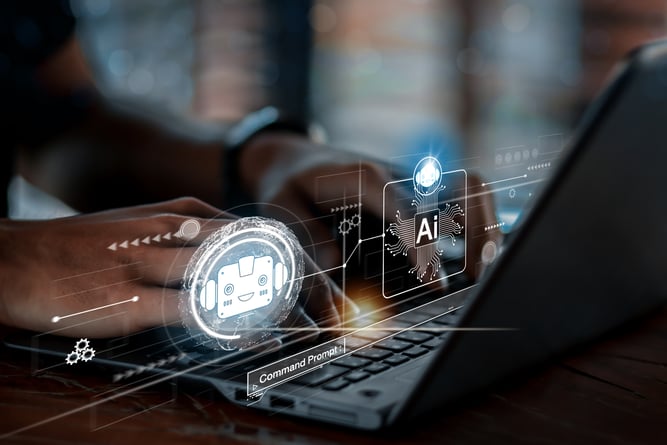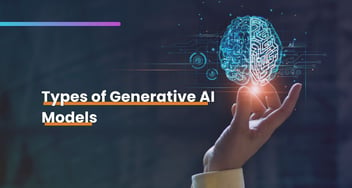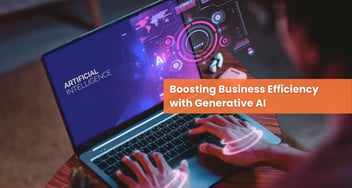Harnessing the Power of OpenAI Models & Its Business Use Cases
OpenAI has made remarkable strides in AI over a decade, culminating in the revolutionary ChatGPT. Its human-like responses have captivated millions, with various applications transforming industries. OpenAI's future promises more groundbreaking models, shaping enterprises and tackling global issues."

OpenAI Models have been seen to deliver frequent breakthroughs in the past ten years, from developing a near-perfect translation natural language model in 2010 to getting to conversational Large Language models in 2022.
OpenAI models have marked a journey of one of the most impactful technologies after steam engines, mobile phones, and social media.
But all of a sudden, it is seen that generative AI has hit the mainstream road of technologies since the launch of ChatGPT.
Now ChatGPT, even though worded to be an AI-powered chatbot, has proven to be one of the most powerful in terms of natural language translations. Not just because of its precision and accuracy, its way of human-like responses have galvanised public attention in a matter of its launch day.
Coming back to what currently is happening in this area and around it, we can say there are three sets of people, one, who know ChatGPT and have tried and regularised it in their everyday tasks; two, who actually understand OpenAI models, its various use cases, impacts, and variety of models, and the third ones, who have no idea what is happening in this part of the world. So, let's jump into this topic.
A Little Timeline of OpenAI Models
So, let’s address the topic for the third set of people and explain a little about what OpenAI is.
OpenAI is an organisation started in 2015 in San Francisco as a not-for-profit. They have researched and developed around Artificial Intelligence and Machine Learning. In 2019 they turned into a for-profit organisation to commercialize their products.
OpenAI utilized the transformer model, specifically GPT (Generative Pre-trained Transformer) and its variants, to power various language-based applications.
The transformer model was first introduced in the paper "Attention is All You Need" by Google brain engineers in 2017, and it revolutionized the field of natural language processing (NLP) due to its ability to efficiently handle long-range dependencies in sequences.
OpenAI used transformer models like GPT to develop advanced language models capable of tasks such as:
- Text Generation: GPT-2 and GPT-3 are examples of transformer-based models that can generate coherent and contextually relevant text. These models can be used for creative writing, content generation, and even chatbots.
- Machine Translation: Transformers can be used for language translation tasks where the model takes a sentence in one language and translates it into another language.
- Sentiment Analysis: Sentiment analysis models based on transformers can determine the sentiment (positive, negative, neutral) expressed in a piece of text.
- Question-Answering: Transformers can be fine-tuned for question-answering tasks, where the model takes a question and generates the most appropriate answer based on the context provided.
- Text Summarization: Summarization models based on transformers can automatically generate concise summaries of long pieces of text.
- Chatbots and Conversational AI: Transformers can be fine-tuned for chatbot application development to carry out conversations with users in a more human-like manner.
The key advantage of transformers is their attention mechanism, which allows the model to focus on relevant parts of the input sequence while processing it. This attention mechanism enables the model to understand the context and dependencies between words, leading to more accurate and contextually appropriate outputs.
To train these large transformer models, OpenAI typically used extensive datasets and powerful hardware infrastructure, including GPUs and TPUs, to handle the computational demands of training models with millions or even billions of parameters.
OpenAI started by developing a system that understood language, which means simple texts. Training itself by feeding on information from the text on the internet.
In 2020, OpenAI launched GPT 3, a text-generating tool that uses algorithms pre-trained with data that they need to carry out simple tasks.
After that OpenAI came up with Codex.
Codex helps programmers to code faster, which means it translates human instructions into computer code.
Next came DALL-E in 2021; this model can create images based on human prompts. And in November 2022, ChatGPT was launched; this OpenAI chatbot was not a simple bot. It could talk about anything and everything, like a human with a right, wrong, or neutral feeling. It can create content like texts or images based on descriptions, and ever since its launch, ChatGPT has recorded more than 100 million active users.
OpenAI Model Use Cases
Listing down all the current and transitioning use cases of AI models.
- Customer Support: OpenAI language models can help businesses to develop AI-backed chatbots that can handle customer queries like a human, hence reducing a lot of response times and freeing up human agents for more complex tasks. These models can automatically ingest large data volumes from various Google review pages and deliver readable ratings from your customers. Machine Learning and Text Analytics transform work on customer comments to understand sentiment and conversation topics.
- Human Resource and Recruitment OpenAI models: These OpenAI models can help streamline the recruitment process by automating the resume screening and shortlisting pipeline and reducing the time and effort spent on hiring and also onboarding candidates.
- Performance Analysis models: The employee performance analysis model analyses performance metrics and identifies top performers, and areas of improvement, and also recommends personalised training sessions. The models are also capable of predictive modelling and use machine learning to predict workforce demand and rostering.
- Natural Language Processing Models: These are created to leverage data presented to the model. They analyse and process textual information from various sources on the internet and give out output as demanded.
- Image, Video, IoT: Artificial Intelligence and Machine Learning with a combination of Video Image data and IoT data are optimizing mining mineral processing automation, which is filling a gap not currently achievable by traditional approaches. Given the high volume of data through these videos and images automating decision support systems and production efficiency are resulting in millions of dollars of profit in the industry.
- Document Analysis: These OpenAI models can evaluate large volumes of document data and draw out valuable insights, displaying output in the way required. These models are also capable of automating manual data entry tasks.
- Personalised Research: By analysing market data, OpenAI models can help enterprises identify their market trends and consumer preferences, delegating them to make data-driven decisions.
- Content Creation: Content-creating models generate personalised, high-quality, human-like content such as videos, articles, blogs, or social media posts.
- Smart Contract Development: OpenAI models can help in creating smart contracts. Along with that, they also enable automated and secure transactions on blockchain networks.
- Cybersecurity tools: AI-powered cybersecurity systems can detect and respond to cyber threats in real time, hence protecting organizations from data breaches and malicious attacks.
- Fraud Transactions Analysis: Due to the large volume of transactions in specific industries there are frequent cases of errors and frauds. OpenAI models have the capability to automatically run large amounts of data, look for financial leakages and report them. The models are capable of ingesting, computing, transforming, and storing big data sets.
- Competition Analysis: AI-powered tools can analyse competitor data and list out opportunities and threats, allowing organisations to stay ahead of the competition.
- Predictive Analysis: Predictive modeling can help achieve this by making use of the historical data of your organization. A thorough consideration from your experts and visualization with adjustments can result in a consistent forecast that can predict the future.
- Customer Churn: For every business, it is important to have customer retention and to even predict and prevent customer churn. So, through AI models, your organisation can deeply analyze customer interaction, execute an accurate perspective of customer behavior, and also identify churn tendencies.
- Robotics & Drones: Autonomous robots and drones have the capabilities to undertake a lot of high-cost and risky operations, be it for recuses, mining, surveying, or navigation in any industry. Concluding a risk-free, less time and resources.
- Operations: OpenAI systems have the ability to reduce operational costs drastically, as it is efficient in automating manual tasks, collecting information, reducing downtime, has faster responses, lower deployment costs, and faster decision-making.
Different OpenAI Models and Their Capabilities
- GPT-3.5 Model: It is a set of models, which can understand and generate natural language text and code.
- GPT-4 Model: It is a set of models that resolves GPT-3.5 issues and can understand and generate natural language text and code.
- DALL-E: It is an OpenAI model that generates and edits images with a natural language prompt.
- Whisper: It is an OpenAI model that can convert audio into text.
- Moderation: OpenAI moderation is a GPT-based service for developers to classify text, ensure compliance with usage policies, filter undesired content, and monitor API inputs/outputs, free for OpenAI API developers with speed, accuracy, and robustness.
Considerations to Keep in Mind While Embedding OpenAI Models
Before developing OpenAI models like ChatGPT in your business system, there is a list of things that you should keep in mind for correct implementation and output.
Empathy and Emotions: Some businesses require a high level of empathy and emotional intelligence in order to delegate sensitive situations or provide support to individuals in need. In these cases, AI models can sometimes provide unexpected responses that may hinder the situation and create wrongful information.
Forte: For highly specialized domains that require a lot of information, in-depth analysis, deep understanding, and expertise, generic OpenAImodels may not have the necessary information or training. In those cases, an expert system is required, which is trained, and specific data is fed to get accurate and up-to-date output.
Sensitive Data: If your organisation works on highly sensitive or confidential information, such as financial data or medical records, depending AI-powered data can pose privacy risks.
Ethical concerns: OpenAI models can possess potential ethical concerns associated with the trained data; such risks include generating biased information or harmful content. In situations where ethical considerations are a top priority, human intervention or alternative solutions would be necessary for accuracy.
The Future - Time Which is Not Far Ahead
OpenAI models have already shown a significant blow across various industries and impacted them in a way that revolutionized how organizations innovate and operate.
OpenAI is rapidly moving ahead in every aspect. As researchers and developers continue to advance, these models are scaling with their training and datasets, making a tremendous impact on outputs and information.
OpenAI will play a prominent role in shaping the future of enterprises. Advanced and groundbreaking models will emerge as this technology evolves, addressing all the issues and challenges that were once thought to be unsolvable. We may see OpenAI-powered solutions generating more human-machine jobs, introducing of new laws, new organizations researching in this area, having sustainable practices, and even solving complex global problems.
Frequently Asked Questions
Have a question in mind? We are here to answer.
What products are based on OpenAI?
![]()
- GPT - GPT-4 is OpenAI's most advanced system, producing more useful responses.
- DALL. · E. DALL.
- Made for developers.
- Whisper - Whisper is a versatile speech recognition model that can identify, transcribe & translate multiple languages.
What is OpenAI?
![]()


%201-1.webp?width=148&height=74&name=our%20work%20(2)%201-1.webp)


.png?width=344&height=101&name=Mask%20group%20(5).png)
















